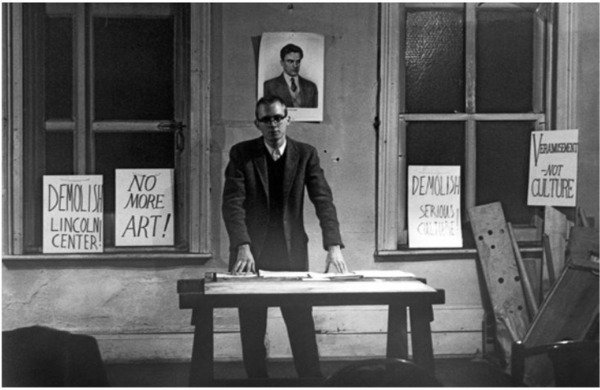About + o - I96I
dal 18/6/2013 al 27/10/2013
Segnalato da
Toshi Ichiyanagi
James Waring
Ray Johnson
Anna Halprin
John Cage
La Monte Young
Robert Morris
George Brecht
Henry Flynt
Simone Forti
Jackson Mac Low
Walter De Maria
George Maciunas
Ray Johnson
Emmett Williams
Nam June Paik
Yoko Ono
Julia Robinson
Christian Xatrec
18/6/2013
About + o - I96I
Museo Nacional Centro de Arte Reina Sofia, Madrid
The expansion of the arts. The exhibition looks at the origins of the change, the experimental activity and the earliest collective actions that pointed to the beginning of an unprecedented expansion of the notion of 'composition' and soon generated a multidisciplinary project that took place in real time/simultaneously over the course of that year.

Curatorship: Julia Robinson and Christian Xatrec
The 1960s may be the 20th century decade that wrote the code for our
contemporary moment. Introducing text/information-based strategies,
real-time, and the rupture of specific media boundaries into artistic
practice, it defined creative criteria, models of authorship mediation,
and new distribution networks that are still very much with us. The
exhibition ± I96I posits a deliberately unfamiliar and anonymous temporal marker to spark debate about how and when the first new theoretical and artistic ground was broken, positing the point at which the
“expanded arts” of the Sixties could first be glimpsed. Choosing a field
of radical invention before the leading names and terms of the decade
were critically and historically defined – considering precursors such
as Anna Halprin and John Cage, and breakthrough 1961 work by figures
such as La Monte Young, Robert Morris, George Brecht, Henry Flynt,
Simone Forti, Jackson Mac Low, Walter De Maria, George Maciunas,
Ray Johnson, Emmett Williams, Nam June Paik, Yoko Ono, et al -- the
exhibition traces the initial crystallization of certain key ideas. At the
center of this is the musical score, subjected to unprecedented experimentation, which became the ur-model for all the arts, rupturing disciplinary and medium specificity, revealing a newly activated creative
field that extends from the postmodern to now.
The period surrounding 1961 revealed a new contingency arising between the artist/ composer/ poet/ dancer/ choreographer and their media. As an emphasis on time and concept began to generate shared terms,
medium was selected not for innate reasons but simply to serve the task
at hand. In this charged moment, John Cage’s impact looms large, along
with other precursor figures such as choreographer Anna Halprin, and
their initiatives subtend the historical matrix of the exhibition. But it
is the new generation with which the show is principally concerned.
Galvanizing figures, in their different ways, La Monte Young, Jackson
Mac Low, and eventually George Maciunas (who founded Fluxus the
following year based on his “1961 experience”), will be presented in relation to a spectrum of emerging projects.
The contentious interaction between generations registers in the relationship between the landmark 1961 publication of Cage’s writings,
Silence, and Young’s An Anthology initiated that same year, which would
rewrite the playbook for all that could be conceived as “experimental
composition.” Ostensibly grounded in music, incorporating the models
of Cage’s circle, An Anthology was dominated by the interdisciplinary
work of the new guard: 27 composers, poets, artists, and choreographers
all presenting their ideas, for the first time comparably, in textual form.
The book’s subtitle – Chance Operations, Concept art, Anti-Art, Indeterminacy, Plans of Action, Diagrams, Music, Dance Constructions, Improvisation, Meaningless Work, Natural Disasters, Compositions, Mathematics, Essays, Poetry, suggests the new territory they broached. Expanding
the printed framework of these activities, other “testimonies” deliver
the actual constellations of artists whose encounters and collective
performances were as ephemeral as the moment itself. The exhibition
projects this through multiple means, such as concert programs, which
point to unexpected events linking Young, Simone Forti, Henry Flynt,
Mac Low, Robert Morris, Toshi Ichiyanagi, George Brecht, Dick Higgins, James Waring, Ray Johnson et al. These documents contextualize
real-time performances alongside physical works, focusing the viewer
on forgotten New York epicenters of art like Yoko Ono’s Chambers St
loft, the Living Theatre, and Maciunas’ short-lived AG Gallery. Such
is the fragile record that the exhibition outlines to provide a new view
onto this formative year, reminding us of “premiere” ‘61 constellations.
Rejecting the model of dominant “authors” historically favored in this
period, ± I96I seeks to give agency to each gesture, to allow individual
artists to be considered in their own right – with a frame lighter than
any that a single name or category of artistic practice would posit. Like
an open score this offers the chance for an interpretation that is different in each moment of encounter. Framed by time, ± I96I draws
upon the ephemeral and the contingent – from sound recordings, to
live dance, to printed scores awaiting realization – it generates a mosaic
of the “first” expanded field that launched the 1960s. The new artistic
formats of 1961, its international networks, its fervent commitment to
typographical design and layouts that support and even articulate the
work, have lost clarity in the present even as they begin to seem more
relevant than ever. The exhibition ± I96I seeks to elucidate a singular
field of experimental activity, around that year, as perhaps one of the
last convincingly utopian moments of collaboration and uncompromisingly radical invention in the 20th century, for all the revelations in can
still bring to the 21st.
Organized by: Museo Nacional Centro de Arte Reina Sofía
Image: Henry Flynt delivering his lecture From Culture to Veramusement, Walter De Maria’s loft, New York, February 28, 1963. Photograph by Diane Wakoski. Courtesy Henry Flynt.
Press department:
Concha Iglesias +34 91 7741005 / 06 prensa1@museoreinasofia.es - prensa2@museoreinasofia.es
Opening June 19, 2013 - 5:30 p.m.
Museo Nacional Centro de Arte Reina Sofía
Edificio Sabatini Santa Isabel, 52 Madrid
Hours
Monday to Saturday and bank holidays from 10:00 a.m. to 9:00 p.m.
Sundays from 10:00 a.m. to 3:00 p.m.
Closed on Tuesdays.
Visitors are kindly asked to clear the galleries 15 minutes before closing.



